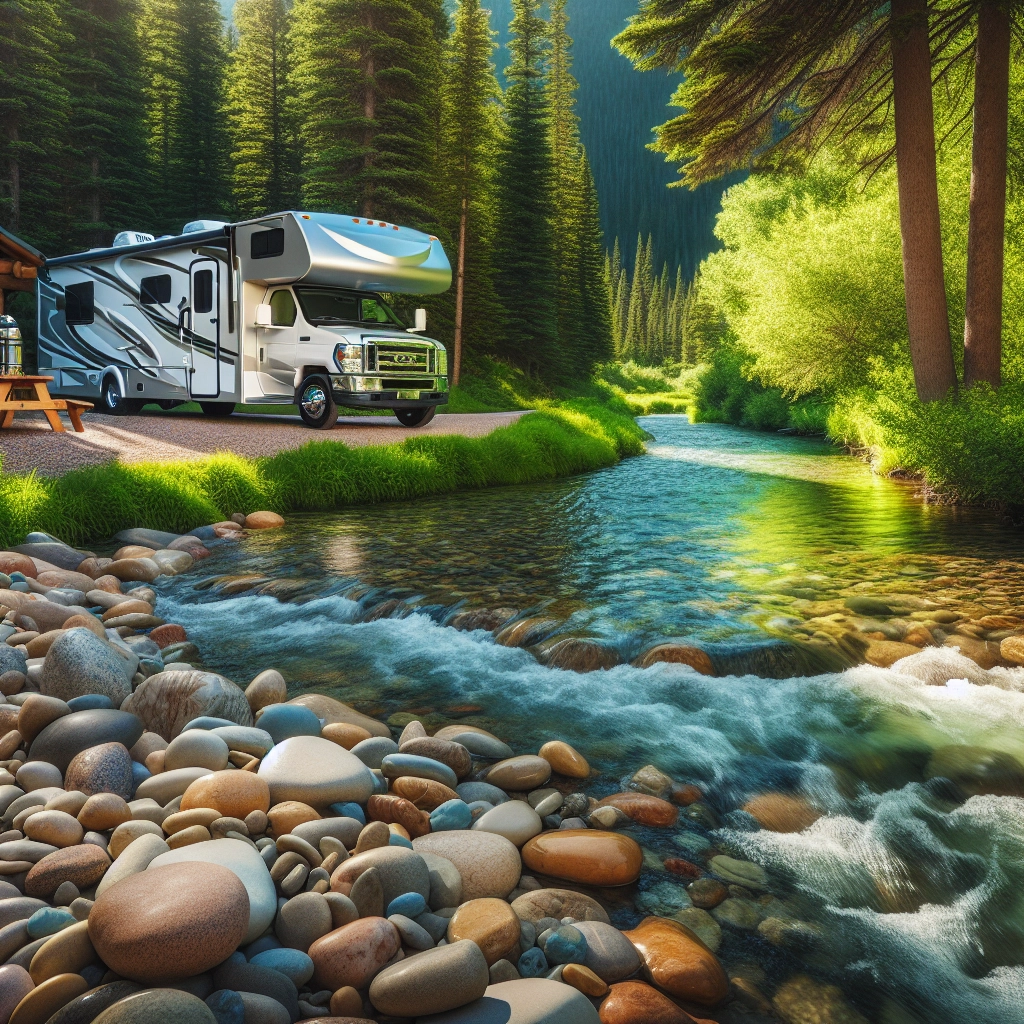Table of Contents

Harvesting Sunlight, Not Stress: RV Solar Systems & Overload Prevention
Exploring the wilderness in your RV doesn’t mean you have to leave the comforts of home behind. Solar power systems for RVs have revolutionized the way adventurers think about energy on the road. But, it’s not just about installing solar panels and forgetting about it. It’s about creating a system that works efficiently without overloading, ensuring you have a constant, reliable power source when you’re off the grid. Let’s get your RV solar system up and running smoothly, so you can focus on making memories, not managing mishaps.
Key Takeaways: Article-at-a-Glance
- Understand the basics of using solar power for boondocking and how it can extend your RV adventures.
- Learn to recognize the signs of an overloaded solar power system to prevent potential damage.
- Discover preventative measures to ensure your solar system runs efficiently and safely.
- Identify the essential components for a high-performing RV solar power setup.
- Gain insights on how to navigate the boondocking experience with a robust and reliable solar system.
The Basics of Boondocking with Solar Power
Boondocking, or dry camping, means setting up camp without hookups to water, power, or sewer. It’s the ultimate test of your RV’s self-sufficiency. Solar power systems are a game-changer for boondockers, allowing you to harness the sun’s energy to power your RV’s electrical needs. The key is to balance your energy consumption with your solar power generation, ensuring you have enough juice for your journey without running your system into the ground.
Recognizing the Risks of Overloading
Just like any power source, your RV’s solar system has its limits. Overloading occurs when the demand on your system exceeds its capacity to produce and store energy. This can lead to drained batteries, damaged components, and even safety hazards. Recognizing the early signs of overloading is crucial. Dimming lights, slow-to-charge batteries, and systems shutting down are all red flags that your system is under pressure.
Preventative Measures for a Worry-Free Adventure
Prevention is better than cure, especially when it comes to your RV’s solar power system. Start by understanding your energy needs and designing a system to match. Regular maintenance checks, balanced energy consumption, and monitoring your system’s performance are all part of the prevention package. By taking these steps, you’re not just protecting your system; you’re ensuring a stress-free adventure out in the wild.
Essential Components for Solar System Efficiency
For your solar system to work efficiently, you need the right components in place. Solar panels, batteries, charge controllers, and inverters are the heart of your RV’s energy system. Each plays a vital role in capturing, storing, and converting solar energy into usable electricity. Choosing quality components and ensuring they are correctly sized and installed is the foundation of a reliable and efficient solar power system.
Navigate the Boondocking Landscape with a Robust Solar System
As you venture into the great outdoors, your solar system becomes your lifeline. A robust system isn’t just about having the biggest panels or the most batteries; it’s about creating a balanced, efficient setup that meets your needs. It’s about understanding the landscape of energy consumption and solar production. With the right knowledge and equipment, you can turn your RV into a self-sustaining home on wheels, no matter where you park it.
Choosing the Right Solar Panels for Your RV
When it comes to solar panels, one size does not fit all. The type of solar panel you choose for your RV can make a significant difference in your boondocking experience. You’ll want to consider factors like efficiency, size, weight, and durability. Monocrystalline panels are known for their high efficiency and compact size, making them a popular choice for RVers. Polycrystalline panels, while slightly less efficient, can offer a more budget-friendly option. Remember, the goal is to select panels that provide enough power for your needs while fitting within the space and weight constraints of your RV.
Understanding Battery Capacity and Management
Batteries are the backbone of your solar power system, storing the energy your panels collect. But not all batteries are created equal. You’ll need to understand the capacity of your batteries, often measured in amp-hours, to ensure they can store enough energy for your needs. Lead-acid batteries are common and cost-effective, but they require regular maintenance and have a shorter lifespan. Lithium-ion batteries, on the other hand, are maintenance-free and have a longer lifespan but come with a higher price tag. Managing your battery capacity effectively means keeping them charged without overcharging, which can reduce their lifespan and effectiveness.
Charge Controllers: Your System’s Gatekeeper
Think of your charge controller as the gatekeeper of your solar power system. It regulates the flow of electricity from the panels to the batteries, preventing overcharging and damage. A good charge controller will also optimize the charging process to ensure your batteries are charged efficiently. There are two main types: PWM (Pulse Width Modulation) and MPPT (Maximum Power Point Tracking). MPPT controllers are more efficient and can handle higher voltages, making them a better choice for larger systems or systems that may be expanded in the future.

Match Your Energy Consumption with Solar Input
The secret to successful boondocking is balancing your energy consumption with the solar power you generate. This means understanding how much power you use on a daily basis and ensuring your solar system can meet those needs. By matching your consumption with your solar input, you can maintain a steady power supply and avoid the pitfalls of overloading your system.
Calculating Your RV’s Energy Needs
Before you can match your solar input to your energy needs, you need to calculate how much power you use. Start by making a list of all your electrical devices and how many hours you use them each day. Then, look at their wattage to calculate the total watts used per day. This will give you a clear picture of your daily energy consumption and help you determine the size of the solar system you’ll need to keep everything running smoothly.
Aligning Solar Output with Daily Requirements
Once you know your energy needs, it’s time to ensure your solar system’s output can meet them. This involves looking at the wattage of your solar panels and the average number of sunlight hours they’ll receive. By multiplying the two, you can estimate the daily power output of your system. If your solar output meets or exceeds your daily energy requirements, you’re in good shape. If not, you may need to adjust your usage or consider expanding your solar system.
Smart Appliances and Energy Conservation Tips
One of the best ways to prevent overloading your RV’s solar system is to use energy wisely. Investing in smart appliances designed for RV use can greatly reduce your energy consumption. These appliances are often more energy-efficient and can be powered directly by your solar system. Additionally, simple conservation tips like using LED lighting, unplugging devices when not in use, and being mindful of your energy usage can all contribute to a more efficient solar setup. By combining smart technology with savvy habits, you can enjoy the freedom of boondocking without the worry of running out of power.
The Safe Circuit: Wiring and Electrical Connections
Wiring is the nervous system of your RV’s solar power setup. It’s what connects your solar panels, charge controller, batteries, and inverter to create a cohesive system. The key to a safe and efficient solar setup is using the right type and size of wiring and ensuring all connections are secure and properly insulated. Poor wiring can lead to inefficiencies, energy loss, and even dangerous situations like short circuits or fires. Always follow the manufacturer’s guidelines and consider consulting with a professional to ensure your wiring is up to par.
Proper Installation Techniques for Safety and Performance
When installing your solar system, precision is key. You want to ensure that every component is correctly positioned and connected. Use appropriate mounting hardware for your solar panels to withstand the rigors of the road. Secure connections are crucial to prevent arcing and potential fire hazards. Additionally, proper grounding of your system is essential to avoid electrical shocks. If you’re not confident in your electrical skills, hiring a certified technician can save you a lot of trouble down the line.
Upgrading Your Inverter: Why It Matters
Your inverter is what turns the DC power stored in your batteries into the AC power that most of your RV appliances use. An outdated or underpowered inverter can be a bottleneck in your system, limiting the usability of the power you’ve harvested. Upgrading to a modern inverter can improve efficiency and provide cleaner power, which is better for sensitive electronics. Plus, some inverters come with additional features like integrated charge controllers or battery monitors, streamlining your system and simplifying maintenance.
Potential Pitfalls in RV Solar System Setup
Setting up your RV solar system can be a complex task, and there are several pitfalls to watch out for. One common mistake is underestimating your energy needs, which can lead to chronic undercharging of your batteries. Another issue is mismatching components, such as pairing a high-voltage solar array with a charge controller that can’t handle the output, leading to energy waste or damage. Avoiding these pitfalls starts with careful planning and may involve consulting with experts to ensure your system is well-matched and capable of meeting your needs.

Monitoring Your System: Keeping an Eye on Power Flow
Monitoring is crucial in managing your RV’s solar power system effectively. It’s not enough to set up your system and hope for the best. You need to keep an eye on how much power you’re generating, how much you’re using, and the health of your batteries. This way, you can make adjustments as needed and avoid being caught off guard by a low battery or an overloaded system. Regular monitoring will help you understand your power flow and make the most of your solar setup.
The Importance of a Reliable Battery Monitor
A reliable battery monitor is like a fuel gauge for your solar power system. It gives you real-time information on your battery’s state of charge, so you know exactly how much energy you have at your disposal. This helps you make informed decisions about your energy usage and can alert you to potential problems before they become serious. A good battery monitor will track not only voltage but also amperage and battery temperature, providing a comprehensive view of your battery’s health.
Understanding Solar System Alerts and What to Do
Your solar power system is smart enough to warn you when something’s not right. Most modern systems come with alerts for various issues like overcharging, undercharging, or overheating. Understanding what these alerts mean and how to respond to them is crucial for maintaining a healthy system. For example, if your system is consistently overcharging, you may need to reduce your energy input or increase your consumption. If you’re getting undercharge alerts, it might be time to conserve energy or consider expanding your solar array. Staying attuned to these alerts will help you keep your system running smoothly and ensure you have power when you need it.
Advanced Strategies for Sustaining Power While Off-Grid
Embracing the boondocking lifestyle means preparing for every scenario. Advanced strategies for sustaining power can make the difference between a trip cut short and one that’s full of off-grid freedom. Let’s explore how you can fortify your RV’s power capabilities to ensure you’re never left in the dark.
Supplemental Power Sources: Generators and Wind Turbines
While solar power is a fantastic resource for boondocking, it’s wise to have backup options. Generators and wind turbinescan supplement your solar setup, especially during periods of low sunlight. A portable generator can recharge your batteries, giving you peace of mind on cloudy days. Wind turbines, though less common in RV setups, can harness the power of the wind at night or during stormy weather. Here’s what you should consider:
- Choose a generator that’s compatible with the size of your RV’s power system.
- Consider the fuel type for your generator, with propane being a clean and convenient option for many RVers.
- Look for quiet generator models to maintain the peace of your natural surroundings.
- If opting for a wind turbine, ensure it’s designed for RV use and rated for the wind speeds you might encounter.
- Always follow safety guidelines when operating supplemental power sources.
Leveraging Weather Forecasts for Energy Planning
Weather plays a significant role in your solar power generation. By keeping an eye on weather forecasts, you can plan your energy usage around the expected sunlight. On days with ample sunshine, you can afford to use more power, while on overcast days, it’s smart to conserve. Use weather apps or local forecasts to stay informed and adjust your power plan accordingly. This proactive approach can help you avoid energy shortages and ensure your solar system provides consistent power throughout your journey.
Maintaining Peak Performance: Regular System Check-Ups
Regular check-ups are the key to maintaining peak performance of your RV’s solar power system. Just like any other vehicle maintenance, your solar setup requires attention to ensure it’s functioning optimally. Inspect your solar panels for cleanliness and damage, check connections for corrosion, and test your batteries’ health. Schedule these check-ups at regular intervals, and especially after harsh weather or long periods of storage. Keeping your system in top shape will extend its lifespan and enhance your boondocking experience.
FAQs: Powering Your RV with Confidence
Now, let’s tackle some of the most common questions RVers have about solar power and boondocking. These answers will help you understand the ins and outs of your system and give you the confidence to power your RV like a pro.
Can I run my air conditioner on solar power while boondocking?
Running an air conditioner on solar power is possible, but it requires a substantial solar setup. Air conditioners are one of the most power-hungry appliances in an RV. To run one on solar power, you’ll need enough solar panels and battery capacity to handle the high energy draw. It’s also important to have a powerful inverter that can handle the surge when the air conditioner starts up. Here’s a quick guide:
– Calculate the total wattage your air conditioner will use per day.
– Ensure your solar panels can generate that amount of power on an average sunny day.
– Have enough battery capacity to store the energy needed, especially if you plan to run the air conditioner when the sun isn’t shining.
– Consider using your air conditioner sparingly and complementing your solar power with a generator if needed.
How do I calculate the size of the solar system I need for my RV?
Calculating the size of your solar system is crucial for successful boondocking. Start by listing all the appliances and devices you’ll be using and note their wattage. Multiply the wattage by the number of hours you’ll use each item per day to get your daily watt-hour total. Then, consider the number of sunlight hours available to charge your system. You’ll want a system that can produce at least as much power as you consume each day. Don’t forget to factor in inefficiencies and potential energy loss. It’s often a good idea to overestimate your needs slightly to ensure you have enough power, even on less sunny days.
What is the best type of battery for my RV solar system?
The ‘best’ battery for your RV solar system depends on your specific needs, budget, and the level of maintenance you’re willing to undertake. Lead-acid batteries, including deep-cycle, AGM, and gel batteries, are cost-effective and widely used. They do require regular maintenance, such as checking water levels and ensuring they’re properly charged to prevent sulfation. On the other hand, lithium-ion batteries are maintenance-free, have a longer lifespan, and offer a higher depth of discharge, meaning you can use more of the battery’s capacity. They’re also lighter and more compact but come with a higher upfront cost. When choosing a battery, consider the total lifecycle cost, not just the purchase price.
How do I know if my solar system is overloading?
Recognizing the signs of an overloaded solar system is critical to preventing damage. If your system is overloading, you might notice that appliances are not running as efficiently, or your inverter is frequently tripping. Your batteries will also struggle to reach full charge, or they may die faster than expected. Another telltale sign is the system voltage dropping below normal levels during use. Modern solar systems often include monitoring tools that alert you to potential overloads, making it easier to take corrective action before any serious damage occurs. Regularly checking these monitors can help you stay on top of your system’s health.
What are the must-have tools for maintaining my RV solar system?
– A reliable multimeter for checking voltages and diagnosing electrical issues.
– A battery monitor to keep track of charge levels and battery health.
– Solar panel cleaning supplies, such as a soft brush and biodegradable soap, to maintain efficiency.
– Insulated tools for safely tightening connections and performing other electrical work.
– A torque wrench to ensure that all bolts and mounting hardware are properly tightened.
– Protective gear, like gloves and safety glasses, when handling batteries and electrical components.
– A detailed maintenance checklist to ensure you cover all aspects of your system regularly.
Maintaining your RV solar system is about being proactive. With the right tools and a regular maintenance schedule, you can keep your system running smoothly and efficiently, ensuring that it provides reliable power for all your adventures.
Now that you’re armed with this information, you’re ready to embark on your solar-powered journey. Embrace the serenity of nature, the independence of off-grid living, and the satisfaction of a well-maintained, eco-friendly power source. Happy travels, and may the sun always shine on your RV adventures!
- Boondocking RVs: Flexible Solar Solutions – 3 March 2024
- Renewable Energy Tips for Full-Time Boondocking RVers – 2 March 2024
- Boondocking Solar Power Systems: Sizing Options & Solutions for Motorhomes – 1 March 2024
